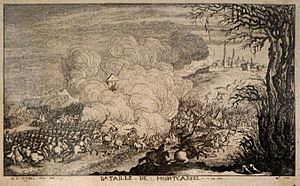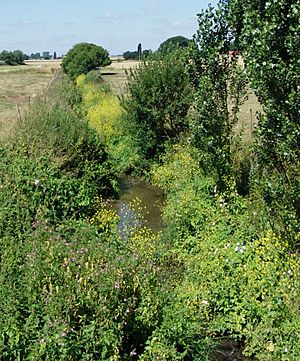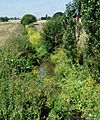Battle of Cassel (1677) facts for kids
Quick facts for kids Battle of Cassel |
|||||||
|---|---|---|---|---|---|---|---|
| Part of Franco-Dutch War | |||||||
 Battle of Cassel, April 1677 |
|||||||
|
|||||||
| Belligerents | |||||||
| Commanders and leaders | |||||||
| Duke of Luxembourg Philippe of Orléans Duke of Humières |
William of Orange Count Waldeck Prince of Nassau-Usingen |
||||||
| Strength | |||||||
| 30,000–35,000 | 30,000–35,000 | ||||||
| Casualties and losses | |||||||
| 3,200–4,400 dead or wounded | 7,000–8,000 dead or wounded 2,500–3,000 captured |
||||||
The Battle of Cassel, also known as the Battle of Peene, was a major fight during the Franco-Dutch War. It happened on April 11, 1677, near a town called Cassel in France. This town is about 15 kilometers (9 miles) west of Saint-Omer.
In this battle, a French army led by the Duke of Luxembourg fought against a combined army from the Dutch Republic and Habsburg Spain. This Allied force was commanded by William of Orange. The French won a big victory.
Before the battle, peace talks were starting. France wanted to capture more towns in the Spanish Netherlands to make its borders stronger. King Louis XIV of France especially wanted to take Saint-Omer and Cambrai. This would give him a better position in the peace talks. William of Orange knew he couldn't save Saint-Omer, but he was determined to fight for Cambrai. This led to the battle near Cassel.
During the battle, both sides tried cavalry attacks first, but they didn't work. Then, a tough fight began between the foot soldiers. The French soldiers on the right side pushed back the Dutch soldiers on their left. French cavalry then scattered the Dutch. At the same time, an attack by the Allied forces on their right was stopped by the French. In the middle, the Dutch almost broke through the French lines. But a cavalry charge led by Philippe of Orléans pushed them back. As his army's sides were collapsing, William ordered a retreat in the late afternoon.
The French won a clear victory. Saint-Omer and Cambrai surrendered soon after the battle.
Contents
Why the Battle Happened
The Battle of Cassel was part of the Franco-Dutch War. This war started in 1672 when France invaded the Dutch Republic. France wanted to expand its territory and power.
France's Goals
In an earlier war (1667–1668), France had captured parts of the Spanish Netherlands. But they had to give back many of these lands. This was because the Dutch Republic, England, and Sweden formed an alliance against France. To break this alliance, King Louis XIV of France made a secret deal with England. He also paid Sweden to stay neutral.
When France invaded the Dutch Republic in 1672, it looked like a quick win. However, the Dutch fought back. Other countries like Spain and the Holy Roman Empire joined the Dutch side. This created new battlefronts for France. Louis XIV decided to pull his armies out of the Netherlands, but they kept the important Dutch city of Maastricht.
Alliances and Peace Talks
The alliance against France grew stronger. Denmark-Norway joined in 1674. England also made peace with the Dutch. Despite this, France still gained land in other areas. After 1675, France focused on making its borders strong and safe.
Peace talks began in Nijmegen in 1676. But Louis XIV always wanted to negotiate from a position of strength. This meant he wanted to win more battles before agreeing to peace terms. To improve their position in a region called Flanders, the French captured several towns in 1676.
For 1677, France planned to take Valenciennes, Cambrai, and Saint-Omer. Louis XIV believed that capturing these cities would complete his "iron border." This strong border would make the Dutch less likely to continue fighting.
Armies Prepare
The French army was very good at moving quickly. They could start their military operations earlier than their enemies. In late February, the main French army of 35,000 soldiers, led by Luxembourg, began to attack Valenciennes. This was a month earlier than usual for fighting to start.
Another 12,000 French soldiers were sent to attack Saint-Omer. These troops were led by Louis XIV's brother, Philippe I, Duke of Orléans, and Louis de Crevant, Duke of Humières. After Valenciennes surrendered on March 17, Luxembourg moved his army towards Cambrai.

Meanwhile, William of Orange gathered about 30,000 soldiers. This included 4,000 Spanish troops. His army met at Roosendaal. William knew he couldn't save Cambrai. But he was determined to fight for Saint-Omer.
William's army was delayed because they lacked money and supplies. The Dutch-Spanish force finally reached Mont-Cassel on April 9. This was near the French-held town of Cassel, about 15 kilometers (9 miles) west of Saint-Omer. The French armies then joined together at Buysscheure on April 10. They left only a few soldiers to continue the attacks on Saint-Omer and Cambrai.
The Battle of Cassel
The two armies were separated by a small river called the Peene Becque. This river ran through the village of Zuytpeene. It wasn't a huge obstacle, but the Dutch didn't realize it was there. This meant they had to give up a surprise attack they planned for April 10.
This delay gave the French time to get ready. They also received more soldiers from Saint-Omer. This made the French army larger than William's by over 5,000 soldiers.
First Attacks
Early on April 11, the Dutch-Spanish army crossed the Peene Becque. But they stopped when they found a second part of the river between them and the French. The French army was set up with Luxembourg and Humières commanding the left and right sides. The main group of foot soldiers and cannons was in the middle, led by Orléans.
Humières attacked with his cavalry without waiting for his foot soldiers. But the Dutch foot soldiers were dug in and pushed him back. A charge led by the Prince of Nassau pushed the French back across the river. However, the Dutch cavalry then faced heavy cannon fire. They retreated to the other side of Mont-Cassel and didn't take part in the rest of the battle.
French Counterattacks
Around midday, Luxembourg attacked again after getting his troops organized. His foot soldiers fought fiercely with the Dutch around some farm buildings. The French eventually took these buildings. A cavalry charge then scattered the retreating Dutch foot soldiers.
At the same time, Humières also attacked successfully on the right side. But in the center, the Dutch soldiers, led by Prince Georg Friedrich of Waldeck, almost broke through the French lines. The French line was only saved after a brave charge led by Orléans himself.
With his army's sides giving way, William ordered a full retreat around 4:00 PM. They headed towards Ypres. Nassau's cavalry helped cover their retreat.
Cassel was a huge French victory. The French lost about 3,200 to 4,400 soldiers killed or wounded. But they caused about 7,000 to 8,000 casualties for the Allies. They also captured 2,500 to 3,000 prisoners. The French also took the Dutch baggage train. However, they spent time looting the baggage, which meant they didn't chase the retreating Allies as much as they could have.
What Happened Next
After the battle, Cambrai surrendered on April 17, 1677. Saint-Omer surrendered on April 20. But France's goal of forcing the Dutch to accept peace terms was still not met.
France had to send some of its soldiers to fight in another area. By August, William of Orange and the Spanish governor had over 60,000 soldiers ready. Luxembourg avoided another big battle. This forced William to try to capture Charleroi instead. This attack was not successful. The French then took Saint-Ghislain in December. This showed that the Dutch were still able to fight.
In England, many people were against France. The victory at Cassel put pressure on the English Parliament to help the Dutch. This made Louis XIV try to downplay his victory. The Dutch didn't want to keep fighting the war. But it became very important for them to restore the Spanish Netherlands as a buffer zone. Their position also improved when William married Mary, the niece of King Charles II of England, in November 1677.
The Battle of Cassel was the first and last time Orléans fought on the front lines. It is said that Louis XIV was jealous of the attention and popularity Orléans gained from the victory.
The Treaties of Nijmegen in 1678 set France's northern border. Spain gave up Saint-Omer, Cassel, Aire, Ypres, Cambrai, Valenciennes, and Maubeuge to France. Except for Ypres, which was returned in 1697, this border is very close to where it is today.
Images for kids
See also
 In Spanish: Batalla de Cassel (1677) para niños
In Spanish: Batalla de Cassel (1677) para niños







